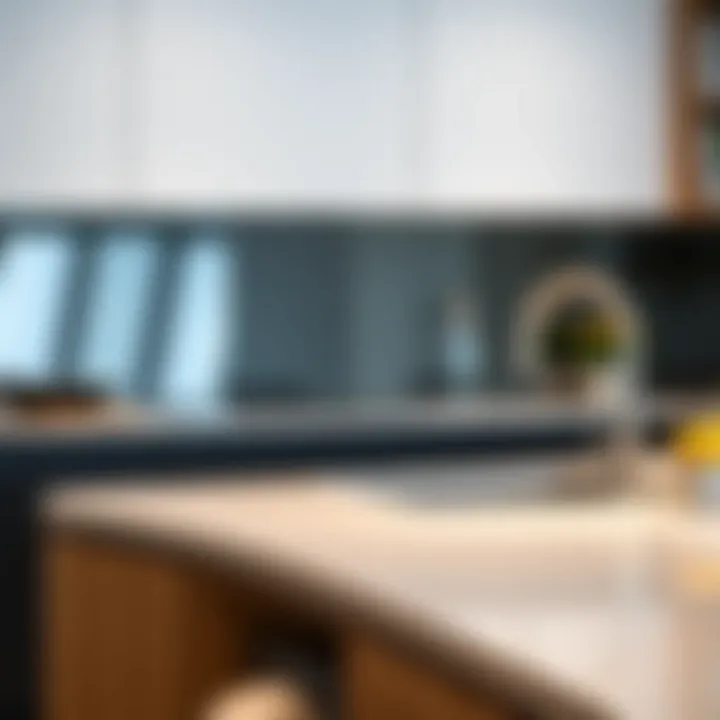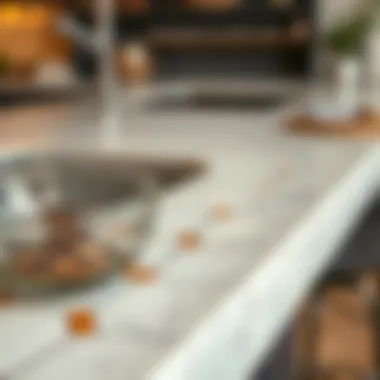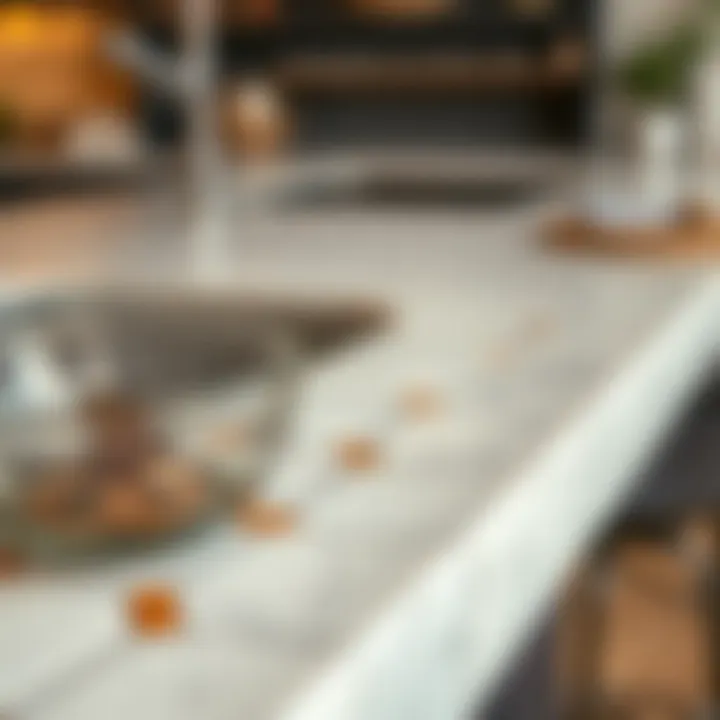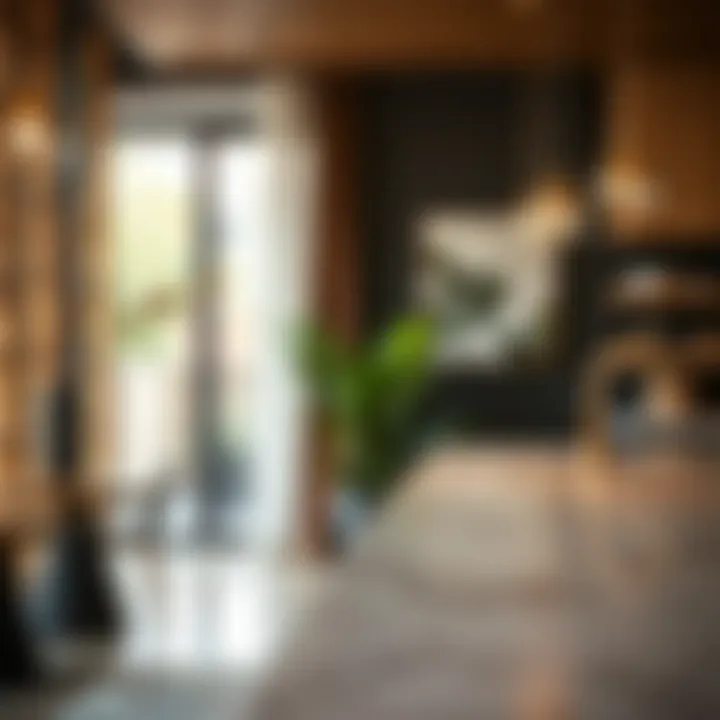Exploring the Beauty of Rounded Countertop Edges


Intro
In the world of furniture design, even the subtlest details can make or break the aesthetic appeal. One such detail that's gaining traction among designers and homeowners alike is the rounded countertop edge. These softly defined curves not only bring a unique visual element into a space but also serve practical purposes that vastly improve the overall functionality of countertops. As we delve into the nuances of rounded countertops, we'll navigate through their design inspirations, practical applications, and the material considerations that define this architectural feature.
Design Inspiration
Trending Furniture Styles
Rounded countertop edges complement a variety of furniture styles gracefully. In contemporary settings, they seamlessly align with minimalist and Scandinavian designs, where clean lines and natural forms reign supreme. These soft edges help to soften the rigid look of straight lines, adding a touch of warmth. On the other end of the spectrum, in rustic or farmhouse styles, rounded edges can enhance the organic, hand-crafted feel that many are drawn to in these aesthetics.
Moreover, the resurgence of mid-century modern design has paved the way for using rounded features as a nod to vintage sensibilities. Imagine a walnut countertop with gentle curves set against bold colors—an instant conversation starter.
Color Palettes and Combinations
Integrating rounded edges into a kitchen or living space opens exciting possibilities for color palettes. Soft, muted colors paired with rounded edges create a serene atmosphere, such as light pastels or earth tones. Conversely, bolder colors like deep blues or greens can lend a sense of drama, especially when juxtaposed with natural wood finishes.
Consider a blended approach, where the rounded contours of a countertop are complemented by a contrasting backsplash or cabinetry. For example, a navy countertop with rounded edges can beautifully stand against creamy white cabinets, creating a sophisticated culinary haven. The idea is to create visual harmony while allowing the rounded features to shine.
"The subtler the design detail, the more impactful its presence can be. Rounded edges signify careful thought in design, enhancing both style and function."
Practical Advice
Furniture Maintenance Tips
Maintaining rounded countertops is typically simpler than one might anticipate. Because they lack sharp angles, these surfaces are less prone to chipping or damage, but that doesn't mean they are maintenance-free. To keep them looking sharp, consider the following tips:
- Regular Cleaning: Use a soft cloth with a mild detergent to prevent buildup of grime.
- Protective Coatings: Depending on the material, applying a sealing agent can help protect the surface.
- Avoid Harsh Chemicals: Strong solvents can dull the finish or harm the surface. Stick to gentle products.
Space Planning Solutions
When designing a space with rounded countertop edges, one must consider how these features will interact with the surrounding elements. Here are some strategies to effectively integrate rounded edges into your space:
- Furniture Flow: Ensure that the rounded edges facilitate movement and accessibility within the space. They should encourage a smooth flow rather than obstruct it.
- Functional Zones: Create distinct areas for cooking, dining, and socializing using rounded countertops to demarcate spaces. For example, a rounded edge can work great for a breakfast bar or a family gathering spot.
- Lighting Considerations: The soft shapes of rounded countertops can be highlighted by appropriate lighting. Pendant lights or under-cabinet lighting can enhance their elegance and make them stand out.
By carefully considering design inspirations and practical applications of rounded countertop edges, homeowners and designers can effectively enhance both safety and aesthetics in their spaces. The allure of these rounded features lies not only in their looks but also in their versatile functionality. As trends evolve, these features will undoubtedly continue to play a significant role in modern furniture design.
For an in-depth understanding, refer to resources like Britannica and Wikipedia. Explore the recent discussions on Reddit about current trends in countertop designs, or check out strategies from top designers on Facebook.
As we explore rounded edges further, let's dive into the material choices that make these countertops not only appealing but highly functional as well.
Foreword to Rounded Countertop Edges
In the world of furniture design, the term "countertop edge" might seem mundane, but it carries significant connotations in both aesthetics and functionality. Rounded edges have emerged as a pivotal feature in modern homes, blending safety, style, and practicality. A countertop isn’t merely a surface; it is an essential part of the space where we cook, gather, and unwind. Thus, understanding the nuances of rounded countertop edges is more than just a design preference—it’s about fostering an environment that is both visually appealing and user-friendly.
The importance of rounded edges lies in their multifaceted benefits. Firstly, they enhance safety in spaces frequented by children or elderly individuals. Sharp edges can pose a real danger, leading to accidents that are easily avoidable with a simple design change. Moreover, these curves enable better flow in busy areas, creating a softer visual transition.
Benefits to Consider:
- Safety: Reduced risk of injury from sharp edges.
- Aesthetic Appeal: Curved designs can add a modern touch to various styles.
- Functional Flow: Enhances movement around the space.
In addition, the advent of rounded edges has traced a parallel with evolving trends in design philosophies, which prioritize comfort and organic forms over rigid lines. As more homeowners and designers lean towards spacious and light-filled environments, the rounded edge fulfills both the visual lightness and the tactile softness that modern interiors call for. The careful incorporation of rounded edges helps break up straight lines, making spaces feel more inviting and alive.
Understanding the significance of these details not only enriches one’s design acumen but also elevates the quality of spaces we inhabit. As we delve deeper into the styles, functional aspects, and material choices associated with rounded edges, we start to see a tapestry of interconnected ideas that culminate in a well-rounded design approach.
"The smallest details often make the biggest difference in turning a house into a home."
With this overview in mind, our next step is to explore the rise of curved edges in modern design, pinpointing how they became a staple in contemporary interiors.
Types of Rounded Edges
Rounded edges are not merely an aesthetic choice in furniture design; they signify an evolution in the way surfaces interact with their environment. Understanding the types of rounded edges and their implications can greatly enhance the choice of materials and the overall design ethos of a space. This section delves into various types of rounded edges, focusing on their unique characteristics, advantages, and considerations, making it vital for anyone involved in home design or renovation.
Standard Rounded Edges
Standard rounded edges are the most recognized type in contemporary furniture design. These edges feature a smooth, rounded profile that not only softens the overall look of a countertop but also serves functional purposes. Homeowners often opt for standard rounded edges in kitchens and bathrooms due to their inherent safety benefits. When installed correctly, they reduce the risk of injury in high-traffic areas.


These edges can also enhance the flow of a room. When you walk past a countertop with sharp edges, you can feel a constant mental alertness to avoid bumping into it. In contrast, standard rounded edges beckon you closer, creating an inviting atmosphere.
"Rounded edges invite interaction, turning stark counters into welcoming surfaces."
Besides safety, they are compatible with various materials, from granite to quartz, and emphasize a clean, modern aesthetic without being overly dramatic. If you're considering a family-friendly kitchen or a cozy café vibe, standard rounded edges are a go-to choice.
Beveled and Chamfered Edges
Beveled and chamfered edges take the concept of rounding a step further through angular cuts. A beveled edge is cut at a slant, creating a sharp transition between the top surface and the edge. Chamfered edges share this slant but are generally more subtle, giving a softer, less pronounced look.
Choosing beveled or chamfered edges often comes down to style preference. While they can add a contemporary edge to modern designs, they can also fit well in transitional spaces, merging traditional and modern aesthetics. The sharpness of a beveled edge can introduce a bit of elegance, which many designers appreciate in dining surfaces or office desks. However, it is essential to consider that such angles may not be the best option for environments filled with children or individuals prone to accidents.
Both styles provide ways to highlight material thickness and enhance the visual appeal of your surfaces. Whether it's a granite backdrop or a butcher-block countertop, the angle at which the material meets the edge can transform the surface from mundane to extraordinary.
Ogee and Bullnose Profiles
The ogee and bullnose profiles are more complex and ornate than the previously discussed types and can woefully elevate the design aesthetics of any kitchen or bathroom. An ogee edge features a concave curve followed by a convex curve, creating a profile reminiscent of an elegant S-shape. This type of edge is often seen in high-end designs, where richness and opulence are key themes. It's particularly suitable for traditional or classical designs.
In contrast, the bullnose profile features a fully rounded edge, creating a seamless transition that feels both warm and inviting. This style is commonplace in family spaces and areas designed for comfort, such as kitchens and living rooms. The bullnose edge complements solid surfaces like granite, marble, or even engineered composites, reinforcing their smooth, sleek nature.
Both the ogee and bullnose options offer unique opportunities for integrating personality into spaces. Choosing one depends on the atmosphere you aim to create:
- Ogee for elegance and tradition.
- Bullnose for a casual, welcoming vibe.
In summary, the type of rounded edge selected carries substantial weight in both functionality and aesthetics. Each style offers different advantages and visual properties, influencing not just the look of the countertop but the overall feel of the space. Being informed about these options empowers homeowners and designers to make strategic choices that reflect their design philosophies.
Functional Advantages
When it comes to rounded countertop edges, the functional advantages are pivotal in understanding their role in furniture design. Beyond being aesthetically pleasing, rounded edges introduce practical benefits that resonate with homeowners and designers alike. These counters, with their gentle curves, are not just fashion statements but also play a significant role in safety and longevity—vital aspects that any well-designed piece should encompass.
Safety Considerations
One of the primary considerations for rounded countertop edges is safety. Sharp corners can present hazards, particularly in households with children or elderly individuals. Accidental bumps can lead to injuries, making rounded edges a smart choice for creating a safer environment.
- Softened Corners: Rounded edges mitigate the risk of cuts and bruises.
- Less Stressful: For individuals with mobility issues, encountering sharp corners can be stressful. With a smooth transition, it’s easier to navigate around the kitchen or work area.
"Safety does not merely enhance the design but redefines it, inviting comfort and practicality into daily life."
This enhancement in safety naturally promotes well-being, encouraging an atmosphere where family and friends can gather without the nagging worry of potential accidents.
Durability and Longevity
When diving deeper into durability, rounded edges offer distinct advantages that can justify their addition to any furniture design. Traditional sharp edges are more susceptible to chipping and cracking over time due to impacts. Rounded edges, on the other hand, distribute stress more evenly, potentially reducing damage and extending the lifespan of the countertop.
- Material Support: Rounded edges often support the structural integrity of the countertop, particularly in materials like stone or engineered composites, by preventing fracture points.
- Ease of Repair: If chips do occur, repairs on rounded edges can oftentimes blend more seamlessly than those on sharp corners, making maintenance less of a hassle.
Furthermore, this enhanced durability often aligns with the demands of a busy household. Surfaces that endure daily wear and tear without losing their charm or function are invaluable. The intersection of practicality and visual appeal typifies the essence of rounded edges in contemporary design, encouraging homeowners to consider their long-term investment in quality and style.
Design Aesthetics
When it comes to interior design, aesthetics carry a heavyweight in creating spaces that resonate with comfort and style. Rounded countertop edges are more than just a practical choice; they are a key player in defining the visual character of a space. Choosing the right edge profile can transform a simple countertop into a signature element that draws the eyes and evokes an emotional response. The importance here lies in understanding how these designs interlace with the broader decor and function of the room.
Visual Appeal and Versatility
Rounded edges provide a sense of softness amidst the hard surfaces typically found in kitchens and bathrooms. They create a harmonious flow that can soften sharp geometric lines commonly used in contemporary spaces. Here are a few aspects highlighting the visual charm and adaptability of rounded edges:
- Softens the Visual Impact: In a world cluttered with angular designs, rounded edges offer an inviting contrast. Thay can turn a stark kitchen into a welcoming culinary haven.
- Enhances Light Reflection: Curved edges catch and bounce light differently than flat or sharp edges, adding depth and dynamism to the design.
- Versatility Across Styles: Whether you’re working with a minimalist, industrial, or a traditional aesthetic, rounded edges can fit in. They are like a chameleon, adapting seamlessly to different themes, thereby enhancing the overall decor.
In practice, consider a rounded edge for a natural stone countertop, such as granite. The fluidity of the curve complements the organic patterns found in the stone, creating a beautiful interplay between material and form. Furthermore, rounded corners are a great choice for social spaces, like islands or bar tops, encouraging interaction without the risk of injury.
Integration with Various Styles
The beauty of rounded countertop edges lies in their ability to elevate various interior design styles. Their integration can either blend in or stand out, depending on the designer’s vision. Here’s how rounded edges align with different aesthetics:
- Modern Minimalism: In this setting, rounded edges provide visual interest without being overwhelming. A simple, rounded profile can ensure the design remains crisp and clean while adding a subtle touch of warmth.
- Rustic Charm: A rounded edge on reclaimed wood countertops embodies the warmth and comfort of rustic design. It invites one to not just look, but to touch and feel, creating an engaging experience.
- Contemporary Eclectic: Combining rounded edges with bold colors and unique materials creates a visually stimulating design. They soften the vibrancy of the eclectic palette, allowing each element to shine without clashing.
"Rounded countertop edges not only enhance safety and comfort but also provide a significant visual interest that reflects the character of the entire design scheme."


In summary, the aesthetics associated with rounded countertop edges extend beyond mere looks. They harmonize practicality with style, enhancing the visual narrative of any space. As such, they are no longer viewed simply as a trend but as a vital component in thoughtful furniture design.
Material Considerations
In the realm of rounded countertop edges, the choice of materials plays a pivotal role in both the aesthetic appeal and functional prowess of the design. Each material carries its own set of characteristics, benefits, and considerations that impact the overall effectiveness in various settings. Homeowners and designers alike need to weigh these factors carefully to ensure a perfect blend of style and resilience.
Natural Stone Surfaces
Natural stone surfaces, such as granite and marble, offer a timeless elegance that enhances the beauty of any interior space. Their durability is unmatched, making them a preferred choice for high-traffic areas like kitchens and bathrooms.
However, it's worth noting that while natural stones can withstand wear and tear, they require diligent care. Regular sealing is essential to prevent staining and scratches. Besides that, the wide variety of colors and patterns available can add unique visual drama to a rounded edge profile, presenting an opportunity to infuse character into a room.
Some practical tips for using natural stones include:
- Opt for edges that complement the natural patterns of the stone.
- Consider finish options like honed or polished, as they both impact the maintenance needs.
"Selecting the right stone can completely transform your space while ensuring lasting performance."
Engineered Materials
Unlike natural stones, engineered materials—such as quartz and solid surface products—offer a uniformity that makes them appealing for modern designs. One major advantage of these materials is their consistency in appearance, which allows for predictable results in both coloring and finishing.
Additionally, engineered materials are generally less porous than natural stone, which minimizes the risk of staining and simplifies maintenance. For a homeowner, ease of care can be a significant selling point. When dealing with rounded edges, the flexibility of engineered materials enables a variety of creative profiles, making it easier to achieve a clean, modern look.
Consider these factors when working with engineered materials:
- Look for certifications that ensure the material is safe and sustainable.
- Explore the options for integrated sinks, which can provide a seamless, sleek design.
Wood and Laminate Options
Wood countertops bring warmth and sophistication into a space, with their natural aesthetics providing a sense of comfort. However, their susceptibility to water damage necessitates careful treatment and maintenance. Rounded edges can help in blending the natural characteristics of wood while also offering enhanced safety. Using hardwoods, such as oak or maple, ensures longevity if properly cared for.
Laminate surfaces, on the other hand, provide a more cost-effective solution. They can replicate the appearance of natural materials without breaking the bank and are often available in a variety of colors and textures.
When using wood or laminate, keep these points in mind:
- Choose finishes that not only look good but also protect the surface from spills and scratches.
- Understand that laminate can be less heat resistant; hence, using trivets or hot pads is advisable.
Installation Techniques
Incorporating rounded countertop edges requires careful consideration of installation techniques. This plays a significant role in ensuring both the aesthetic appeal and functional longevity of countertops. The precision with which these edges are crafted can make or break a design. Moreover, a proper installation can contribute to safety, minimize maintenance needs, and significantly elevate the value of both the furniture and the overall space.
Precision and Craftsmanship
The art of precision in installing rounded edges is not just a matter of skill but also of understanding the material at hand. Every cut needs to be measured and executed with accuracy. This is where craftsmanship comes into play; it's crucial that the individual installing the countertop appreciates the nuances of the material, whether that be natural stone like granite or engineered materials like quartz.
- Attention to Detail: Small discrepancies in cutting or shaping the material can create visible flaws that diminish the visual appeal.
- Consistent Finish: Achieving a uniform finish along the edge not only enhances aesthetic value but also improves usability—no one wants a countertop that feels jagged or uneven.
- Techniques Used: Skilled craftsmen may use CNC machines for precise cuts, while hand tools can afford more creative and intricate designs. Each method has its merits, and often a combination is employed to achieve the desired outcome.
The craftsmanship involved in rounded edges reflects on the overall quality of the finished product. Homeowners and designers should prioritize hiring professionals who demonstrate strong expertise in this area. The better the craftsmanship, the more effortlessly those rounded edges will integrate into the greater design.
DIY vs. Professional Installation
Choosing between DIY installation or hiring a professional can significantly impact both the process and the final product.
DIY Installation
Choosing the DIY route offers flexibility and can be cost-effective. However, it requires a strong grasp of the skills necessary for achieving precision.
- Tools Required: A DIY enthusiast needs various tools like jigsaws, routers, and sanding equipment, along with a steady hand for constructing rounded edges.
- Learning Curve: There is often a significant learning curve. Newbies might find themselves making mistakes that can lead to frustration or additional expenses down the line.
Professional Installation
On the flip side, hiring professionals often brings a peace of mind that is hard to duplicate.
- Expertise: Professionals have seen it all; their knowledge can help avoid common pitfalls that arise during installation.
- Efficiency: A trained installation crew can often complete the task more quickly than an inexperienced DIYer, minimizing disruption in the home.
- Warranty on Work: Many professional installers offer warranties, which can provide added reassurance that any issues arising post-installation will be addressed without incurring further costs.
Ultimately, homeowners should weigh the risks and rewards associated with each approach. For intricate designs or materials requiring special treatment, professional installation may be the prudent choice.


"The difference between a successful installation and a flawed one often boils down to the knowledge and skill of the installer."
Whether you choose to go it alone or bring in the experts, understanding these installation techniques will help you achieve those desirable rounded edges, adding both beauty and practicality to your spaces.
Maintenance and Care
Caring for rounded countertop edges is essential not just for aesthetics but also for the longevity of the materials involved. Well-maintained edges resist wear and tear, maintain their original charm, and contribute to the overall look of the space. By incorporating proper care routines and promptly addressing any minor issues, homeowners can preserve their investment in beautiful furniture design.
Cleaning and Upkeep Tips
Keeping the edges of your countertops clean doesn't require an extensive cleaning arsenal. Here are some straightforward approaches to ensure that those rounded edges shine:
- Use a Soft Cloth: For day-to-day cleaning, a damp microfiber cloth does wonders. It captures dust and debris without scratching the surface. Don't get too heavy-handed with abrasive scrubbers; they can cause more harm than good.
- Mild Detergent: Mild dish soap mixed with warm water can help to clean any greasy or sticky residues. Use the mixture sparingly; you want to clean without oversaturating the material. Always wipe with a cloth and then dry the edges to avoid streaks.
- Avoid Harsh Chemicals: Be mindful of using strong cleaners. Products with bleach, ammonia, or acid are often too harsh for the delicate finishes on rounded edges. Stick to gentle household cleaners for the safest bet.
"Regular cleaning not only enhances the appearance of rounded edges but also aids in prolonging the life of your countertops. A small effort today can prevent bigger problems tomorrow."
- Seal and Protect: If your countertop is made from natural stones like granite or marble, consider applying a sealant regularly to protect against stains and etching. The frequency depends on the specific material and usage but typically every six months is a good rule of thumb.
Repairing Damage
Accidents happen, and even the most careful homeowners may encounter chips or scratches on their rounded edges. Understanding repair techniques can save time and money down the line.
- Assess the Damage: First, inspect the extent of the damage. Small chips may only need a quick fix while larger gaps might require professional attention.
- Use Epoxy Fillers: For minor chips, a clear epoxy filler can seamlessly blend with the countertop. It offers a robust fix that can withstand the wear that comes with daily use.
- Light Sanding and Polishing: If scratches appear, lightly sand the area with fine-grit sandpaper to smooth it out, then polish it with a gentle touch using a suitable polish for the countertop material.
- Professional Help: In cases where damage is significant, calling a professional is often the best practice. Experts can ensure repairs are not only effective but also maintain the material's integrity and appearance.
Ensuring the longevity and beauty of your rounded edges isn't merely an afterthought; it's a deliberate practice that can enhance the life of your furniture. Regular maintenance and careful handling can keep those edges looking fresh and stylish for many years.
Current Trends in Rounded Edges
In today’s world of furniture design, the trends surrounding rounded edges are more than just a nod to aesthetics; they represent a significant shift in how we perceive both function and style in our living spaces. As homes evolve into multifunctional hubs, rounded countertops are gaining traction not just for their beauty but for their practicality. Homeowners, designers, and decorators alike are finding that these designs make a compelling statement—both visually and contextually.
Understanding why rounded edges are trending requires a look at several factors: their safety features, their ability to enhance flow and movement in a room, and their adaptability to various styles. More than mere decoration, these edges embody a design philosophy that prioritizes comfort and functionality alongside visual appeal.
Emerging Styles in Interior Design
As minimalism and organic design principles continue to dominate contemporary interior aesthetics, rounded edges are at the forefront of this transformation. Designers are now weaving these elements into various styles, including modern, bohemian, and even rustic themes. For instance, a mid-century modern kitchen may feature a simple, rounded countertop that contrasts beautifully with angular cabinetry. Similarly, in a bohemian setting, fluid lines create a welcoming atmosphere by encouraging movement and conversation.
Some notable styles include:
- Soft Minimalism: Where simplicity meets comfort, using rounded edges to soften stark lines.
- Scandinavian Designs: Emphasizing functionality and minimalism while incorporating warmth through smooth, continuous lines.
- Eclectic: Mixing and matching rounded elements with more traditional designs adds character without feeling out of place.
This trend toward softer shapes creates an inviting environment, making spaces feel more approachable. Interior designers are increasingly using rounded edges to provide visual breaks, avoiding hard lines that can feel jarring, ultimately enhancing the overall ambiance of a room.
"Round edges promote a sense of equality and community, harking back to the humble dining table that gathers us all together.”
Sustainability in Material Selection
The conversation around sustainability has become more prominent, influencing not only what materials we use but also how shapes augment the design's lifecycle. Designers are now sourcing materials that are both eco-friendly and durable, making rounded edges an ideal choice. For example, recycled materials like glass and composites can be crafted into rounded formations, reducing both waste and the environmental footprint of our furniture.
Some key trends in sustainability include:
- Reclaimed Wood: Perfect for achieving rounded profiles while promoting environmental consciousness.
- Biodegradable Surfaces: These materials allow for innovative shapes while ensuring minimal impact on the planet.
- Local Sourcing: Using locally sourced materials minimizes transport emissions and supports local economies.
Embracing these sustainable practices not only enhances the appeal of rounded countertop edges but also contributes positively to the environment. The dual benefit of aesthetics and sustainability makes them a contemporary favorite among discerning home decorators and architects.
Finale
As we wrap up our examination of rounded countertop edges, it’s crucial to emphasize their multifaceted significance in furniture design. These edges aren’t just for aesthetics; they serve a pivotal role in enhancing both functionality and safety in kitchen and living spaces. By blending beauty with practicality, rounded edges help create environments that are not only visually appealing but also user-friendly.
Embracing Curved Edges in Design
In the current era where modern design is often characterized by sharp lines and angular forms, rounded edges stand out as a refreshing alternative. They invite not only a sense of warmth but also a softer touch in an otherwise rigid landscape of contemporary furniture. Homeowners looking to revamp their spaces can find that these curves encourage a natural flow, making the environment more inviting.
For designers, curved edges open up a plethora of creative possibilities, allowing for integration with various styles ranging from minimalist to rustic. The transition becomes seamless as the rounded corners can adapt to different themes without clashing or creating visual dissonance.
"In design, it is the little details that often create a big impact. Rounded edges might seem subtle, but they hold a powerful influence on aesthetic and function."
Moreover, when considering safety, particularly for families with small children, rounded edges significantly reduce the risk of sharp injuries. This safety feature is becoming increasingly important in modern living environments where comfort and security are paramount.
Final Thoughts
The importance of incorporating rounded countertop edges in your design choices cannot be understated. Not only do they add elegance and style to furniture, but they also cater to practical needs that benefit everyday living. Utilizing these curves fosters an environment where functionality aligns beautifully with design. As you plan your next renovation, think about how rounded edges can harmonize with your vision, creating a space that's safe, stylish, and distinctly yours.
For more information on furniture design principles, check out resources like Wikipedia or relevant discussions on Reddit for diverse insights and communal experiences.



